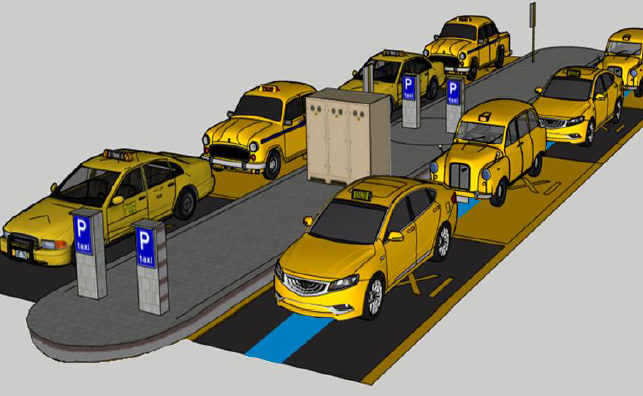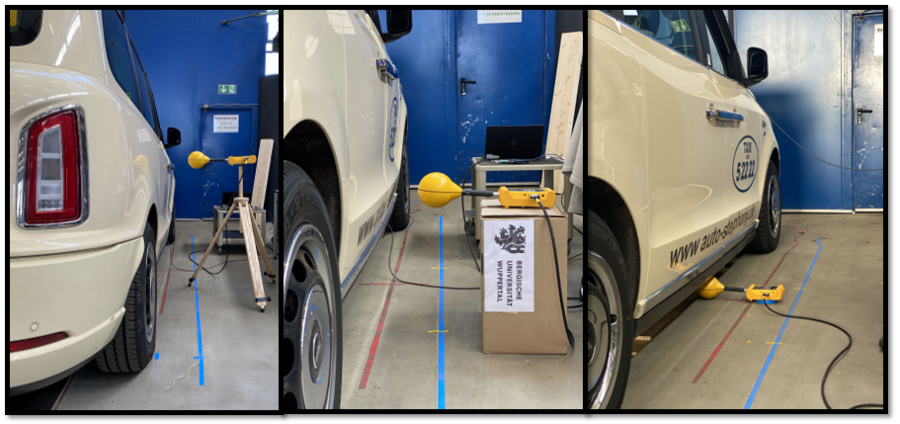TALAKO - Taxi Charging Concept for Public Space

Project Duration:
October 2019 - December 2022
Consortium:
- University of Wuppertal
(Chair EES and TET)
- University of Duisburg
(Chair IAM and NES)
- INTIS GmbH
- RheinEnergie AG
- LEVC
- Taxi Stephany
- TAXI RUF Köln
Funding:
Federal Ministry for Economic Affairs and Climate Action (BMWK)
Website:
www.talako.uni-due.de
Articles:
SmartCity Cologne, BUW Presse, n-tv Beitrag
Book:
Induktive Ladung für den öffentlichen Raum
Description
Lately there has been a change in thinking in German cities, but especially in large cities, concerning the local environmental pollution to be found there. In many cities, the limits set by the EU cannot be met, which poses an increasing threat to the people living there and the local climate.
In many places, measures have been taken to electrify local public transport, which accounts for a high proportion of local emissions. However, it is not only the scheduled buses in large cities that contribute a large share of emissions, but also private transport and the services offered by cab companies. Accordingly, the TALAKO project goes further step by setting the goal of equipping a purely electricall cab fleet and providing the necessary electrical energy using an inductive charging system.
An inductive charging concept is developed and tested on a prototype system in Mülheim an der Ruhr.
The development of optimized coil geometries, in cooperation with the project partner INTIS, is critical to achieve high efficiency in inductive energy transfer, and it resembles another focus of the project.
The core objective of TALAKO envisions contactless charging of electric cabs during the waiting process. In order to enable a cross-project application of the developed system after the end of the project, a modular design according to the building block principle is pursued.
The resulting flexibility allows application-specific dimensioning of the components. The necessary system requirements and hardware components will be defined, designed and applied.
A transfer to application scenarios with different queue lengths or vehicle models is thus ensured after the end of the project and is supported by developed recommendations.
Various (research) projects have already been carried out nationally and internationally on the inductive charging of electric vehicles in local public transport (LPT). Nevertheless, inductive charging systems are mainly installed and operated on private property. Thus, the results emerging from the TALAKO project can provide important information regarding the operation of inductive charging systems in public areas.
The system to be developed should meet all requirements (e.g., compliance with limit values) for systems in public spaces. From an electrotechnical point of view, the project provides further insights into the system behavior of inductive charging system configurations under realistic conditions, e.g. with different vehicle states (loaded/empty, clean/dirty, etc.). In addition to statements on the robustness of these systems, the project addresses the possible efficiency optimization and shielding design improvements for further reduction of stray magnetic fields. That also includes further scientific findings for optimizing the measurement methods used and thus combined computer-aided simulation methods for electromagnetic (environmental) compatibility (EMC(E)) investigations. Another important goal is to ensure electromagnetic compatibility so that the system developed does not pose any health hazards to humans or animals. This also includes consideration of real-life scenarios (e.g. passengers with pacemakers). If relevant standards or limit values cannot be complied with, appropriate countermeasures are taken. The development of shielding structures or the optimization of coil designs to attenuate the electromagnetic field next to and in the vehicle can, for example, represent suitable countermeasures.

Fig.1: Illustration of the Pilote Phase Installation

Fig. 2: Implementation of the Wireless Charging System in the Taxi Lane

Fig. 3.: Magnetic Field Measurement of the Wireless Charging System at Different Points
